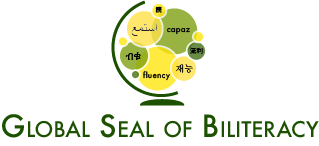How Global Seal of Biliteracy Certification Maximizes Opportunity for Higher Ed Students
"We provide the language credentials needed to equip a globally connected workforce."
Introduction to the Global Seal of Biliteracy
The Global Seal of Biliteracy is a universal credential that celebrates language skills at three levels of fluency and expands future opportunities for its recipients. The Global Seal is available in over 100 languages through tests that have been approved by our independent Board of Advisors. The Global Seal credential may be awarded by a school to its bilingual students in any career area, providing a powerful job-seeking advantage. A uniform standard empowers awardees to be a valuable asset in multilingual environments. We are committed to providing access to language credentialing to anyone who can demonstrate their bilingualism via testing. The Global Seal of Biliteracy enables recipients to showcase their language skills to any school or employer across state lines and national borders, with a unique serial-numbered document.
The Global Seal of Biliteracy’s powerful 3-step pathway recognizes the value of differing levels of language fluency. Each award level can serve a meaningful purpose in our increasingly diverse communities and interconnected world. Each Global Seal credential is awarded through validated external testing, indicates the language and level of skill demonstrated, and is serial-numbered so it can be easily added to a resume, C.V. or LinkedIn. Whether a learner is at the Functional, Working, or Professional Fluency level, their Global Seal certificate will articulate their bilingualism and open doors. Currently, nearly 20% of Global Seals are issued by colleges and universities.
Demand for multilinguals is increasing in a variety of work sectors.
Highlights from the Ipsos Public Affairs 2019 Making Languages Our Business: Addressing Foreign Language Demand Among U.S. Employers survey of 1,200 upper-level managers and human resource professionals.
9 out of 10 U.S. employers report a reliance on U.S.-based employees with language skills other than English, with 32% reporting a high dependency.
90% of U.S. employers say there is a high demand for foreign language skills among with projections that this need will continue to grow. A majority (64%) of employers in the healthcare and social assistance sector are the most likely to expect an increase in demand, followed by employers in trade, education services, professional and technical services and construction.
The languages in greatest demand among employers also rank as having the biggest shortages. Eighty-five percent of U.S. employers say they’re reliant on Spanish, making it by the far the most sought-after language. This is followed by Chinese (34%), French (22%) and Japanese (17%).
Lack of bilingual employees impacts the bottom line. One in four employers surveyed acknowledges losing or being unable to pursue a business opportunity over the lack of foreign language skills
U.S. employers are almost twice as likely to deploy their foreign language capacity domestically than internationally, with 97% using these skills to some extent domestically, but only 54% doing so overseas
Global Seal of Biliteracy and Higher Education Collaborative Opportunities
The Global Seal of Biliteracy credential is being used by colleges and universities in a number of ways. Most commonly, the certificate is awarded to language students at the end of a second year program who have qualified for a credential through testing. This provides students with a vital assessment of their language skill as well as the opportunity to earn an entry level language credential. For those who choose to go further, it provides a meaningful pathway to “level up” by taking additional language coursework or by pursuing study abroad, internships or career-specific learning opportunities. The Global Seal benefits non-majors/minors who would otherwise not be able to highlight their language skill by providing a credential that is understood in the workforce and can give them significant pay differentials in careers such as medicine, business and social services. For students continuing language study, it incentivizes their language acquisition which results in increased program retention as studies have shown.
Other exciting opportunities include:
Award the Global Seal of Biliteracy as a competency-based credit to current degree-seeking students with bilingual skills as well as to non-degree seekers. Because the Global Seal can be earned through remotely proctored testing, this advantage easily extends to online students.
Use the Global Seal of Biliteracy in tandem with Dual-Credit High School programs as an incentive and pathway to higher level coursework at the university level.
Use the external testing required for the Global Seal as a positive benefit to language testing for course placement, benchmarking and course exit evaluation.
Attract talented language learners to your program, especially important in less common languages.
Provide the Global Seal of Biliteracy certificate to non-majors/minors in other academic areas and schools to enhance their future opportunities.
Offer community service and outreach opportunities in local communities where other languages are spoken by identifying skilled bilinguals through the Global Seal program.
Attracts non-traditional students; reach new students like polyglots or professionals by offering to arrange testing for the Global Seal of Biliteracy.
If you have questions on how your university can maximize student opportunities through language credentials, please send them to info@theglobalseal.com

